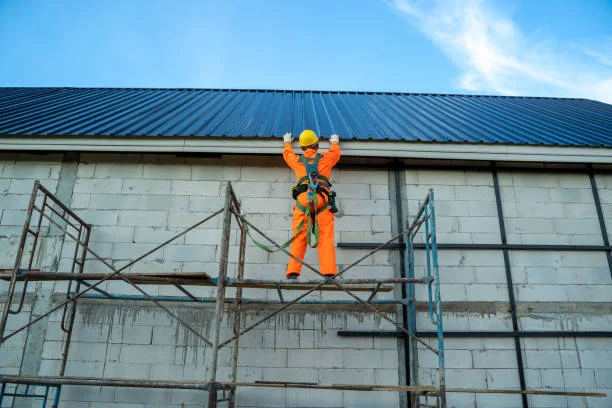When it comes to working at height, roofing is among the most dangerous occupations. Roofing professionals face numerous hazards while working on steep, sloped, or flat roofs. Falls from height are the leading cause of injury and death in the construction industry, making it essential for roofers and contractors to implement fall protection systems to safeguard workers on every job site, notes leading property management Springfield Oregon company, Oregon Campus Rentals.
Fall protection is not just a regulatory requirement but a critical step in ensuring the well-being of everyone involved. In this blog post, we’ll explore the fall protection essentials that every roofing company should consider roof safety solutions to keep workers safe and compliant with safety regulations.
Why Fall Protection Is Crucial for Roofers
Roofing is inherently risky, with workers often balancing on unstable surfaces and exposed to unpredictable weather conditions. The risks are amplified when proper safety measures aren’t in place. According to the Occupational Safety and Health Administration (OSHA), falls are the number one cause of fatalities in the construction industry. When a roofer falls from a height, the consequences can range from severe injuries to death.
Proper fall protection is not just about meeting OSHA standards; it’s about keeping workers safe and ensuring a secure environment. Roofing contractors must prioritize fall protection to prevent accidents, avoid legal repercussions, and build a reputation as a responsible, safety-conscious business.
Liked what you read? This related post is another hidden gem.
Key Components of Roof Fall Protection
To ensure roof safety on every job site, a comprehensive fall protection system should be implemented. This system should be designed to prevent falls, minimize injury in case of a fall, and provide secure anchor points for workers. Below are the essential components of an effective fall protection strategy for roofing jobs:
Personal Fall Arrest Systems (PFAS)
A Personal Fall Arrest System (PFAS) is designed to prevent a worker from hitting the ground if they fall. It includes several components:
- Harness: The worker wears a harness that distributes the force of a fall across the body, reducing the chance of injury.
- Lanyard: The lanyard connects the harness to a secure anchor point. It should be adjustable and strong enough to withstand the forces of a fall.
- Anchor Point: A secure point on the roof, such as a roof safety anchor, to which the fall arrest system can be attached. It should be strong enough to withstand the impact of a fall.
- Shock Absorber: Some lanyards have built-in shock absorbers that slow the fall and reduce the impact on the worker’s body.
When used correctly, PFAS can be a lifesaver. It’s essential that roofers wear a harness at all times when working at height.
Guardrails and Safety Barriers
For certain types of roofs, guardrails and safety barriers are excellent fall protection options. These are physical barriers that prevent workers from falling off the edge of a roof. Guardrails are often used on flat roofs or when workers are performing tasks near the roof’s edge.
Guardrails must be designed to withstand the impact of a fall. OSHA recommends that guardrails be at least 42 inches high with a mid-rail that is located between 21 inches and 30 inches from the surface. They should also be strong enough to resist the force of a fall, typically with a strength of 200 pounds applied in any direction.
Roof Safety Anchors
Roof safety anchors are secure attachment points fixed to the roof that provide a reliable place to tie off a worker’s harness. These anchors are essential for both permanent and temporary fall protection systems.
There are several types of roof safety anchors, including:
- Permanent anchors: These are installed during the construction or installation of a roof and are meant to last throughout the roof’s life.
- Temporary anchors: These can be installed and removed as needed for specific roofing projects, like maintenance or repairs.
Choosing the right safety anchor depends on the type of roof and the work being performed. Permanent anchors offer long-term safety, while temporary anchors are a flexible solution for short-term projects.
Lifelines and Horizontal Systems
Lifelines are flexible, horizontal lines that workers can attach their fall arrest systems to as they move along the roof. There are two main types of lifelines:
- Horizontal lifelines: These run along the length of a roof or building and allow workers to move freely from one point to another while remaining secured.
- Vertical lifelines: These are fixed to a single point on a structure and can be used when workers are ascending or descending a roof.
Lifeline systems are especially useful for large or complex roof structures where workers may need to move across large areas. Horizontal lifelines allow for greater flexibility and mobility, making them ideal for roofing jobs that involve extensive movement.
Training and Education
Fall protection systems can only be effective if workers are properly trained on how to use them. Training is a crucial aspect of fall protection, as it ensures that workers understand how to safely use fall arrest equipment, recognize hazards, and implement safe work practices.
Training should cover:
- How to properly fit and adjust a harness
- How to inspect fall protection equipment
- How to identify and mitigate hazards on the roof
- Emergency procedures in case of a fall
OSHA requires that workers who are exposed to fall hazards be trained to recognize the dangers associated with working at height and be able to use fall protection systems effectively.
Weather and Job Site Conditions
In addition to using fall protection equipment, roofing contractors should consider weather conditions and the job site environment when assessing fall hazards. Rain, snow, high winds, or slippery surfaces can increase the likelihood of falls. Roofing companies should stop work during unsafe weather conditions and ensure that the roof is dry and clear of debris before workers begin their tasks.
Conclusion
Roofing is a challenging and risky profession, but fall protection essentials can make all the difference. By incorporating personal fall arrest systems, guardrails, roof safety anchors, lifelines, and proper training into every roofing job, contractors can significantly reduce the risk of falls and injuries on the job site.
It’s not enough to simply meet safety regulations; a roofing company’s commitment to fall protection is a reflection of their dedication to worker safety. By ensuring that fall protection measures are in place and adhered to on every job site, companies protect their workers, minimize liability, and maintain their reputation as a safe and reliable business. In the world of roofing, safety is the most valuable asset on any job site—because protecting lives should always come first.
Catch up on the latest updates anytime from 2A Magazine.







